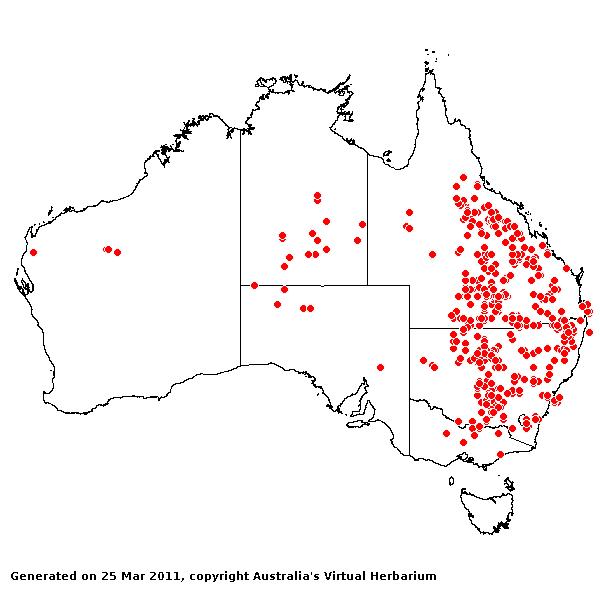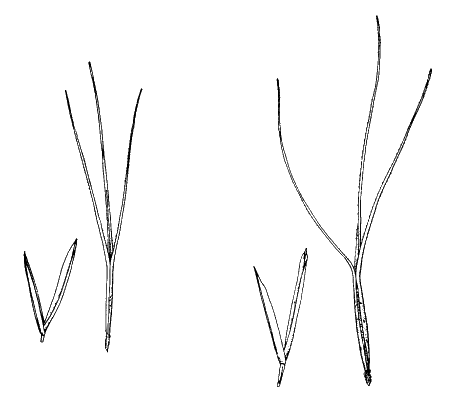Aristida jerichoensis (Domin)Henrard. Meded.
Rijks. Herb. Leiden
54A: 270 (1927).
Classification. (GPWG 2001) : Subfamily
Aristidoideae. Aristideae.
Basionym and/or
Replacement Name: Aristida
ingrata var. jerichoensis Domin, Biblioth. Bot.85(2): 346
(1915).
Type of Basionym or
Protologue Information: HT: K. Domin s.n., Mar 1910, Australia: Queensland:
Mitchell Dist.: Dividing Range bei Jericho
(PR; IT: BRI, L (photo, BRI)).
Key references
(books and floras): [1981] M.Lazarides in J.Jessop (ed)., Flora of
Central Australia (449), [2002] D.Sharp & B.K.Simon, AusGrass,
Grasses of Australia, [2006] J.Jessop, G.R.M.Dashorst, F.M.James, Grasses
of South Australia (324), [2008] S.W.L.Jacobs, R.D.B.Walley &
D.J.B.Wheeler, Grasses of New South Wales (129).
Illustrations:
[1983] J.C.Tothill & J.B.Hacker, Grasses of Southern Queensland
(106(41)), [2006] J.Jessop, G.R.M.Dashorst, F.M.James, Grasses of South
Australia (325, Fig. 257 as var. subspinulifera),
[2008] S.W.L.Jacobs, R.D.B.Whalley & D.J.B.Wheeler, Grasses of New South
Wales, 4th edn (129).
Derivation: L.
-ensis, denoting origin. From Jericho,
Queensland, Australia.
Habit.
Perennial. Culms 30–60 cm tall. Mid-culm internodes glabrous. Lateral branches
sparsely branched or branched. Leaf-sheaths glabrous on surface. Ligule a
fringe of hairs, 0.5–1 mm long. Leaf-blades flexuous, flat or conduplicate or
involute or convolute, 16–18 cm long, 2 mm wide. Leaf-blade surface scabrous.
Inflorescence.
Inflorescence compound, a panicle. Panicle linear or lanceolate, 4–15 cm long,
1–2 cm wide.
Spikelets.
Spikelets pedicelled. Fertile spikelets 1-flowered, comprising 1 fertile
floret(s), without rachilla extension, lanceolate, terete, 5–9 mm long.
Glumes.
Glumes similar, thinner than fertile lemma. Lower glume lanceolate, membranous,
keeled, 1-keeled, 1–3 -nerved. Lower glume surface glabrous. Lower glume apex
muticous or mucronate. Upper glume lanceolate, 5–9 mm long, membranous, keeled,
1-keeled, 1–3 -nerved. Upper glume surface smooth to scabrous, glabrous. Upper
glume apex muticous or mucronate.
Florets.
Fertile lemma 4–7 mm long, without keel, 3 -nerved. Lemma apex awned, 3 -awned.
Median (principal) awn without a column. Lateral lemma awns present. Palea
without keels. Anthers 3. Grain 3.5–4.5 mm long.
Continental
Distribution: Australasia.
Australian Distribution:
Northern Territory, South Australia, Queensland, New South Wales.
Northern Territory:
Central Australia North, Central Australia South. South Australia:
Flinders Ranges. Queensland: Burnett, Darling Downs, Gregory North,
Leichhardt, Maranoa, Mitchell, Moreton, North Kennedy, Port Curtis, South
Kennedy, Warrego. New South Wales: Central Coast, Northern Tablelands,
Central Tablelands, North-Western Slopes, Central-Western Slopes, South-Western
Slopes, North-Western Plains, South-Western Plains, North Far Western Plains,
South Far Western Plains.
Notes. A.
jerichoensis is similar to A. benthamii from which it differs by its
lemma awns being more subequal. It usually grows in more arid areas than A.
benthamii. It has two varieties, var. jerichoensis with smooth lemma
furrows and var. subspinulifera with muricate lemma furrows.
Infra -specific
taxa: var. jerichoensis, var. subspinulifera.
Margins of lemma
furrow with one to several rows of tubercles A. jerichoensis var. subspinulifera
Margins of lemma furrow smooth A. jerichoensis var. jerichoensis



